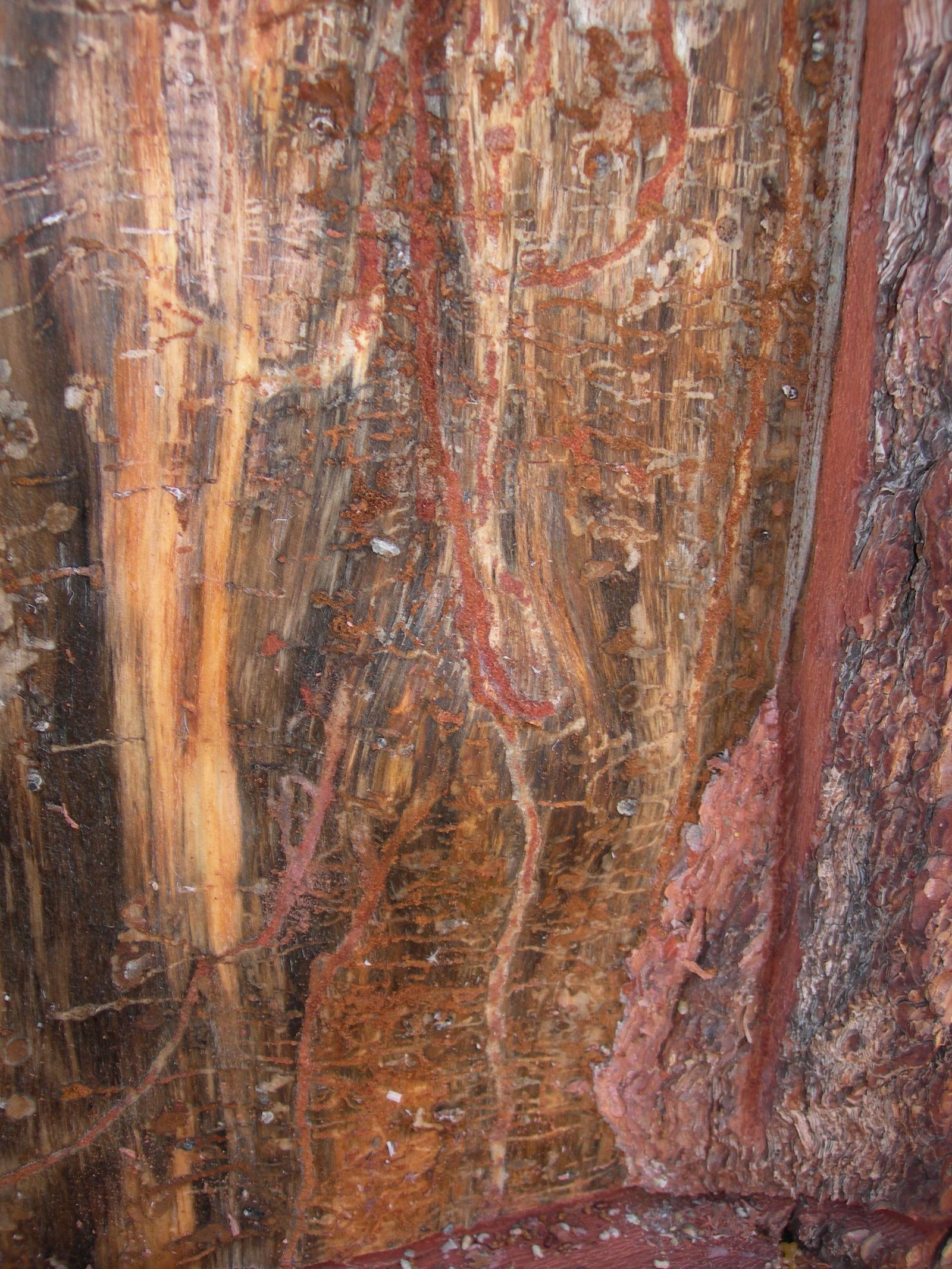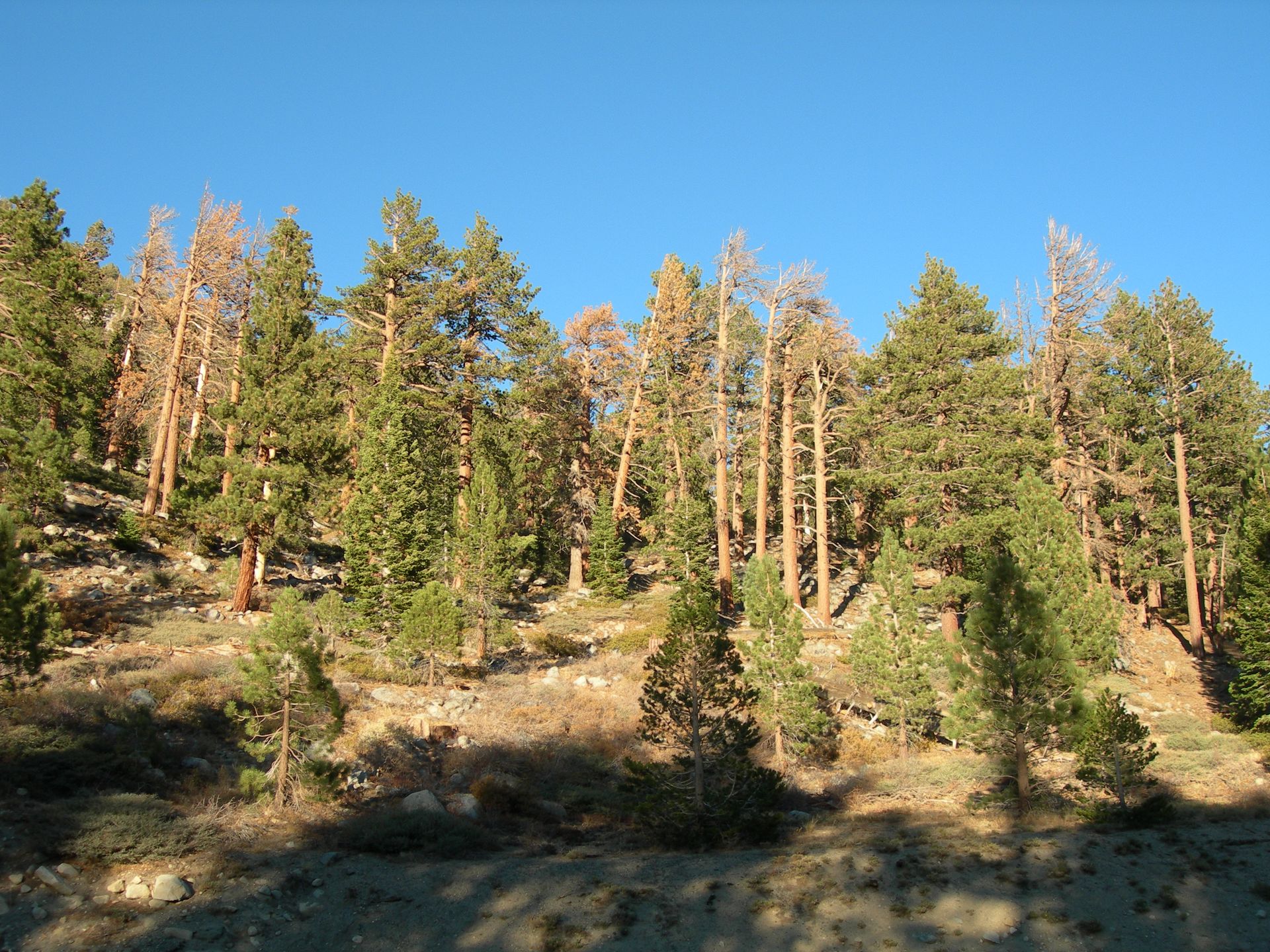Jeffrey Pine Beetle
Dendroctonus jeffreyi
Key Wildlife Value:
The Jeffrey pine beetle creates pine snags ranging in size from the largest Jeffrey pines down to 20 cm (8 in) dbh. Mortality typically occurs in scattered, large individual trees, but during outbreaks small groups of mature and pole-size trees often are attacked and killed. Colonized trees provide good woodpecker foraging habitat. Canopy gaps are created in mature stands, increasing structural and sometimes compositional diversity. Trees killed by D. jeffreyi eventually contribute to levels of down wood when they break or fall over.
Distribution in Oregon and Washington:
Found in southwestern Oregon.
Hosts:
Jeffrey pine.
Diagnosis:
Jeffrey pine beetle is the only beetle attacking Jeffrey pine that causes conspicuous masses of pitch, called pitch tubes, to form on the tree bole at points of entry. The appearance and biology of this beetle is nearly identical to that of the mountain pine beetle, except that Jeffrey pine beetle is a little larger and exclusively colonizes Jeffrey pine. Pitch tubes are cream to red-colored and about 13 to 25 mm (1/2 to 1 in) in diameter. They occur randomly on the bole and are not associated with limb junctions or old wounds. They are usually present on attacked trees, however, severely stressed trees may not produce enough pitch for normal tube formation. Positive diagnosis is best achieved by removing a portion of the bark so that egg gallery patterns may be inspected. Orange-red boring dust on the bark and around the bases of trees also provides an external clue to inspect more closely for the presence of Jeffrey pine beetle, although wood borers also produce boring dust. Woodpeckers foraging for D. jeffreyi larvae frequently cause small holes in the bark that expose the sapwood, and flakes of bark at the bases of trees.
Egg galleries, which look very much like mountain pine beetle galleries, are typically straight, 60 cm (24 in) or longer, and run longitudinally up the tree bole.

Jeffrey pine beetle often kills trees in groups. Infested trees usually fade within one year, changing from green to yellow-green to red-brown. Beetle-killed trees usually die with a full complement of foliage.

Life History:
The Jeffrey pine beetle has a one-year life cycle, with four stages of development: egg, larva, pupa, and adult.

Important habitats and outbreak dynamics:
When population levels are low, Jeffrey pine beetle, like the western pine beetle, breeds in large (30.5 cm or 12 in, and larger), scattered individual trees that are growing very slowly, and in trees damaged by lightning, wind, fire, other insects, or disease. Jeffrey pine beetles normally do not reproduce in freshly cut trees, but will breed in recently windthrown trees. D. jeffreyi frequently occurs in association with the California flatheaded borer, Phaenops californica; pine engraver, Ips pini; and emarginate ips, Ips emarginatus.
During outbreaks, D. jeffreyi tends to kill trees in relatively small groups, and attacks apparently healthy trees with diameters as small as 20 cm (8 in), causing mortality in pole-size stands as well as mature stands. Groups of trees killed in pole-size stands during outbreaks may number up to 30 trees. In California, there is some observational evidence that Jeffrey pine beetle infestation centers tend to expand outward from one year to the next as the beetles infest a series of neighboring trees.
In southwestern Oregon, Jeffrey pine trees generally are found growing in open stands on ultramafic, or serpentine, soils. In this area, Jeffrey pine beetle activity is most commonly associated with fires, heavy dwarf mistletoe infections, and very dry years.
Opportunities for Manipulation to Increase Wildlife Habitat:
It may be possible to create snags or groups of snags in dead wood-deficient stands by baiting trees with the Jeffrey pine beetle pheromone attractant. However, use of this method would be largely experimental, and it is unknown to what degree it could reliably achieve desired outcomes.
Potential Adverse Effects:
Structural diversity may be decreased when Jeffrey pine beetle selectively kills very large Jeffrey pine trees. In mixed conifer stands containing Jeffrey pine legacy trees, tree species diversity also may be reduced. Legacy pines representing important and relatively rare structure that would take centuries to replace may be removed from dense stands in a relatively short period by Jeffrey pine beetle activity. Jeffrey pine beetle-caused mortality may cause detrimental effects to aesthetic values and public safety on recreational and other developed sites.
How to Minimize the Risk of Adverse Effects:
Prevention of overcrowded conditions and undue tree stress is the most effective method of managing Jeffrey pine beetle. Adverse effects are most effectively minimized by encouraging optimal growing conditions for host stands through the use of stocking level regulation (of both tree and shrub competition) and by managing for moderate or lower levels of dwarf mistletoe infection. Prescribed burning might be an appropriate management tool for regulating stocking in Jeffrey pine stands. In areas where annual expansion of Jeffrey pine beetle infestation centers is observed, some benefit might be achieved by removing currently infested trees.
Thinning around individual legacy trees to promote tree vigor could minimize the risk of Jeffrey pine beetle attack. These spot treatments would involve removal of all shrubs and trees beneath the canopy of the legacy tree to a prescribed distance beyond the dripline.
References
Furniss, R.L., and Carolin, V.M. 1977. Western forest insects. USDA Forest Service, Washington, D.C. Misc. Publ. 1339. 654 pp.
Goheen, E.M. and E.A. Willhite. 2006. Field guide to common diseases and insect pests of Oregon and Washington conifers. USDA Forest Service, Pacific Northwest Region, Portland, OR. R6-NR-FID-PR-01-06. 335 pp. http://www.biodiversitylibrary.org/bibliography/80321#/summary
Smith, S.L., R.R. Borys, and P.J. Shea. 2009.Jeffrey pine beetle. Forest Pest Leaflet 11 (revised). USDA Forest Service, Portland, OR. FS-R6-RO-FIDL#11/003-2009. 8 p.